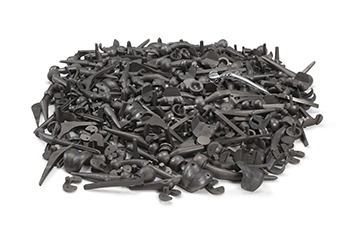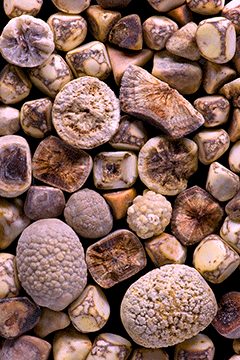
01/29/2019
People don’t often associate beauty with gallstones. Or artificial hips. Or metastasizing cancer cells, salmonella bacteria or the hepatitis B virus.
A number of contemporary artists, however, are finding aesthetic inspiration in the many ways things go wrong with the human body. SUNY Cortland is showcasing their work in a multidisciplinary project comprised of two exhibitions that find art in medical research through Friday, Feb. 22, at Dowd Gallery.
The exhibition, “Hidden Beauty and Beyond Obvious: Exploring the Aesthetics of Medical Science,” will feature an opening reception on Thursday, Jan. 31, from 4 to 6 p.m. in the gallery in the Dowd Fine Arts Center located at the corner of Prospect Terrace and Graham Avenue.
It will also feature a one-day symposium, “Beyond Obvious,” on Wednesday, Feb. 6., during which several of the artists will discuss their work and one will offer a workshop.
Half of the exhibition, “Hidden Beauty,” is a traveling photographic exhibition organized by Christine Iacobuzio-Donahue, M.D., of Memorial Sloan Kettering Cancer Center and Norman Barker, an associate professor and medical photographer at Johns Hopkins University. The display features views of medical and scientific research, including ones made possible through microscopes, X-rays and other medical scanning equipment.
"Sometimes the worse the disease, the prettier it is under the microscope," Iacobuzio-Donahue said in a recent Johns Hopkins interview. "The whole point with art is to make someone think or feel something they haven't before. Diseases are part of the natural world, and they themselves could have elements that are very beautiful. It’s hard to see that when you have these preconceived notions about them."
This collaborative project by Iacobuzio-Donahue and Barker asks the viewer to consider the aesthetics of the human body, disease and biology. According to Barker and Iacobuzio-Donahue, disease is a dynamically powerful force of nature that acts without regard to race, religion or culture.
In conjunction with “Hidden Beauty,” Dowd Gallery will showcase four artists across disciplines within the realm of medical science, in an exhibition titled “Beyond Obvious.”
Each of the artists whose works are displayed in “Beyond Obvious” — Emily Culver, Holland Houdek, Lionel Maunz and Boryana Rossa — provide a personal interpretation of the clinical aspect of human life.

Houdek, a visual artist and professor of metalsmithing at Nazareth College, combines the aesthetics of jewelry making and sculpture with medical science. Her three-dimensional metal sculpture, objects and wearable art focuses on medical implants and pieces inspired by medical anatomy. It investigates ideas regarding values placed on body enhancements outside as well as inside of the human body.
Culver, a multimedia artist, makes art objects that reference tangible objects — such as handles, blades, vessels and furniture — which in doing so question their perceived purpose. By manipulating familiar visual forms in undefined ways, Culver invites the viewer to re-frame their own understanding and purpose for these items. The process of unveiling and recognition of the viewer’s projection of self onto these objects results in a state of speculative reality.
Maunz creates graphic drawings and sculpture that study bodies in agony, torture and failure.
“I’m trying to give my work some essence of what it is to inhabit the body,” Maunz said of his disturbing portrayals of physical depravity. Rossa, an interdisciplinary artist and curator, builds on her personal life experiences — including her decision to not get reconstructive surgery after breast cancer surgery — and injects them into her works in the field of electronic arts, film, video, performance, photography and biotech art. An assistant professor of art, video and transmedia at Syracuse University, Rossa often uses her body as a tool to convey distinct messages on various subjects such as identity, gender, political and economic reality or a local history through the lens of a global perspective.
“The wide use of media and technology in contemporary society and the new methods of mythology creation based on the availability of digital devices is another current topic I am working on,” Rossa said. “Science and technology create the future we will live in.”
The Wednesday, Feb. 6, symposium will feature two lectures and a studio workshop, panel presentation and film screening. All events are at Dowd Gallery, unless noted otherwise. This project was largely funded by the SUNY System Administration and its Conversation in the Disciplines Program.
- At 10 a.m., “Hidden Beauty” project organizer Barker will discuss “The Wonder of the Scientific Image.” Barker’s talk will focus on the inception and development of his collaborative project as well as the creative processes accompanying the medical field and scientific research and discoveries.
- At 11:30 a.m., Houdek, whose metalsmithing work is part of the “Hidden Beauty” exhibition, will present “Part of the Process.” She will address her fabrication techniques within the context of the aesthetics of medical research, her path to interdisciplinary conversation and benefits of merging disciplines.
- That afternoon, Houdek will hold a metalsmithing workshop at 1 p.m. in the sculpture studio located in Old Main, Room G-35.
- At 3 p.m., Rossa will give an artist’s talk about her work shown in the gallery as well as her recent experience during a residency for the research and development of the bio-art project, “The Mirror of Faith.” Related to the genetic predisposition of spirituality — the so-called “God gene” — this project is a collaboration with the biologist Dr. Michael Edel of the University of Barcelona as part of the Grid Spinoza program, funded by the European Commission.
- A panel discussion of "Art in Epidemics in Society” will begin at 4:30 p.m. Presenters will include Prihodova; Christa Chatfield, a SUNY Cortland associate professor of biological sciences; and several of the Honors Program students who collaborated in an art project as a part of the College’s Epidemics in Society course. The students’ work will be displayed in the Mary and Joseph Daniels Foyer outside Dowd Gallery.
- The symposium events will conclude with a reception at 6 p.m. in Dowd Gallery.
On Thursday, Feb. 21, the gallery will screen George C. Wolfe’s 2017 documentary film “The Immortal Life of Henrietta Lacks” at 5 p.m. The film is based on the book by Rebecca Skloot, The Immortal Cells of Henrietta Lacks. Cells collected in the 1950s from Lacks, a poor black woman dying of cancer, multiplied so rapidly that they continue to be the basis for research and treatment of major illnesses today. The 2010 book juxtaposed health industry profit off the cell line with no consideration for basic health care opportunities for the offspring of a poor, dying black woman whose cell line was taken and exploited without her knowledge or permission.
The exhibit is sponsored by the Art Exhibition Association, Auxiliary Services Corporation, Campus Artist and Lecture Series, SUNY System Administration and the Conversations in the Disciplines Program. It and all related programs are free and open to the public.
Gallery hours are 10 a.m. to 4 p.m. Monday through Friday and by appointment. Contact Dowd Gallery interim director Jaroslava Prihodova at 607-753-4216 for more information or regarding group tours.